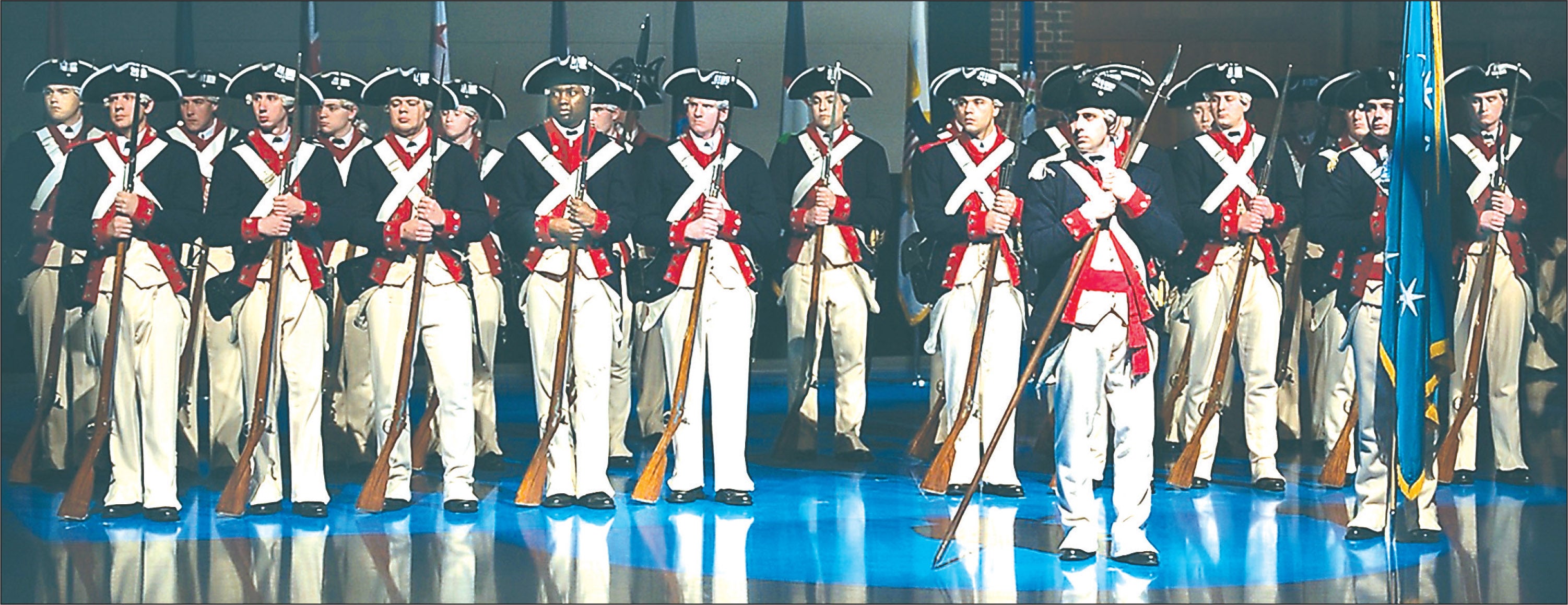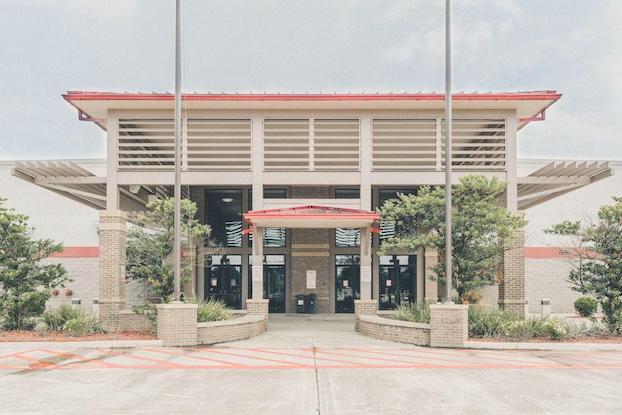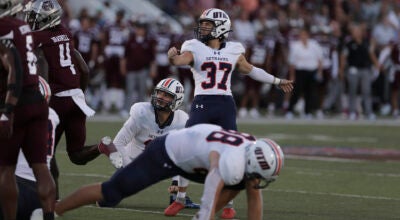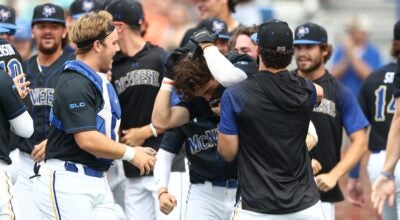Attorney Tristan Gruspier recalls his three years as part of an Army infantry unit that has served the nation since 1764
Published 5:00 am Sunday, November 21, 2021

- Tristan Gruspier, first rank, fifth man from left, in the 2nd Platoon of The Commander-In-Chief’s Guard, during an Indoor Retirement Ceremony. (Special to the American Press)
Before recently passing the state bar exam and joining a local law firm, Tristan Gruspier had a very different career in which he served as a goodwill ambassador of the United States in a selective unit that prides itself on excellence and being the face of the Army to the world.
Service to one’s country is something that was instilled in Gruspier since he was a child.
“My grandfather was enlisted Army, my dad was enlisted Army and I got to an age where I realized I either needed to do it or not do it,” he said. “At that point I had already graduated from LSU and was working both at the state capitol doing political work and I was bouncing to and from Washington, D.C., and I realized it was something I had to do.”
Gruspier said he’s happy he did because he has friends who are in their 30s now who live with regret for not having had the experience of serving in the military.
“Going to try and do something like that is definitely a lot harder when you’re older.”
He speaks from experience, admitting basic training was a rude awakening.
“I don’t want to say I was the ‘old guy’ in my basic training, but I started when I was 22 or 23 so I was already around the power curve because the majority of the guys were 18 years old and right out of high school and ready to go. Plus, I wasn’t in the best of shape going in,” he said with a laugh. “But I gutted it out and did what I needed to do.”
Gruspier said he chose to enlist in the infantry and after graduating basic training was assigned to a unit in Fort Carson, Colo. Unbeknown to him, as he continued to serve he was also checking off the boxes required for placement in the The Old Guard — he received secret clearance, made a high score on his aptitude test, had no strikes on his military record and was a member of the infantry.
“I was in Fort Carson for about two and a half years and one day I got orders to go to the museum on post and I couldn’t figure out who I had ticked off to get reassigned to this little museum by the front gate. I was befuddled.”
When he asked his commanding officer about the orders, he was sent to the non-commissioned officer.
“He just started laughing at me when I asked and said, ‘You’ve been marked to go to The Old Guard since about a year after you joined the Army. You’ve been on their radar.’ ”
The Old Guard is the oldest active-duty infantry unit in the Army, serving the nation since 1764. It is the Army’s official ceremonial unit and escort to the president.
Gruspier said during an election year, The Old Guard builds up its forces about 120 percent to have enough members to fulfill the needs of the multiple inaugural ceremonies.
“Because of that, because of my qualifications, and because my platoon sergeant put my name on the list and never told me about it I got my orders,” he said.
Gruspier said while he ultimately enjoyed the experience, he initially was upset with the transfer.
“My unit was preparing for deployment so I asked if I could get out of it so I could go serve with them but I was told no because I was selected.”
Gruspier said his father served as an Army combat engineer and his grandfather, who served in Korea, was a supply sergeant. Their experiences were far different than what Gruspier would go through in The Old Guard, which he described as “a completely different realm of responsibilities.”
“If a face of a soldier needs to be represented to a foreign dignitary or even to the general public, nine times out of 10, it’s a member of The Old Guard,” he explained. “The soldiers who present the flag during NFL games or at the Super Bowl, that’s the Honor Guard of The Old Guard. There’s just so many missions that we are assigned.”
He said The Old Guard is comprised of two battalions — one assigned to Arlington Cemetery whose assignments include guarding The Tomb of the Unknown Soldier and participating in military funerals; the other is ceremonial and covers Pentagon and White House arrivals and the Twilight Tattoo military pageants.
“It’s never something that I would ever have imagined,” he said. “I was assigned to the Commander and Chief’s Guard, which is a special unit within The Old Guard and our main uniform was the American Revolutionary soldier uniform.”
When prime ministers or other foreign dignitaries arrived in Washington, D.C., Gruspier’s unit would stand guard as representatives of the Army’s vast history.
“It’s a lot of standing around and not moving for hours on end,” he said with a chuckle. “It’s the exact opposite of what you’d think a military infantry would be, honestly.”
Before any soldier goes out on a mission, a “grader” inspects their uniform and the platoon’s formation. The Old Guard is no different.
“There’s 110 individual items on the spread sheet that the grader is checking and they will sit there and go through every one,” he said. “The medals we wear have to be an eighth of an inch higher than the pocket. Each element is graded and you have to have a 90 or higher to pass. If you didn’t pass, your platoon loses its certification and you have to redo the entire recertification process, which is not fun.”
Gruspier jokes that his training for The Old Guard was essentially “arts and crafts time for the Army.” While other soldiers were being issued canteens and weapons, he was given ribbons.
“When you see the ceremonial medals worn by soldiers, especially those assigned to the Tomb, we have to make those,” he said. “We’ll get the blanks and then you have to go in and make a special brace inside that allows the cap to sit perfectly flat and then you learn how to make all the medals that go on our uniforms. They’re all handmade. We also have horseshoes on the bottom of our dress shoes and you have to sand them, and you have to paint them and you have to clean them. You spend the first month of your time in The Old Guard not only making your uniform but learning about The Old Guard.”
Once he was assigned to his platoon, he spent weeks learning how to use and march with a musket — as well as proper care for his American Revolution-style wig.
“Here I am in the Army and I’m actually learning how to roll a wig and store it, things you’d never imagine,” he said. “We also had to use a press to redo the uniform after every ceremony. If your creases in the sleeve were not correct, you were written up for that. The level of detail given to training, the uniforms and perfection is a level that I don’t know is done in any other part of the Army. There’s such a high level of detail involved.”
Because each mission he served was vastly different, Gruspier said he can’t pick a favorite experience.
“One mission we had to meet with the secretary of defense because he wanted the visiting prime minister to speak with an everyday soldier,” he said. “Another time I was attending a ceremony and when it was over I was speaking to this older gentleman with an Australian accent and long story short he turned out to be the ambassador of Australia. It’s things like that you wouldn’t think you would be doing as a soldier.”
He said his most memorable experiences were Memorial Day observances at Arlington Cemetery.
“The Thursday before, the entire regiment goes out after dusk and places individual flags at every tomb,” he said. “What a lot of people don’t know is that the cemetery is set up into different sections and in the Civil War section you would be amazed at how many unknown soldiers there are. It’s not just the Tomb, there’s thousands of others. There is so much respect there. The minute you hit the gate, no one speaks. There’s so much reverence given to the past and the soldiers who have come before. It really hits you when you get there.”
Gruspier ultimately served nearly six years in the Army, three of which were in The Old Guard, under Presidents Barack Obama and Donald Trump.
His unit served at the Pentagon.
“It is definitely easy to get turned around inside there,” he said. “Once you get to the middle of it, there’s so many higher-ups that it’s been made a salute-free zone. Normally, lower officers always salute higher officers but in that situation there’s so many generals you’d never make it across the hall. You’d find yourself nonstop saluting.”
Gruspier said the attention to detail he needed in the Army has carried over into his second career as an attorney for Robichaux, Mize, Wadsack, Richardson & Watson.
“It’s like OCD times 10,” he said with a laugh. “In the legal field, it’s the same thing. If you miss one thing you can throw off an entire case.”
Gruspier said his interest in law began at the age of 16. With a month-old driver’s license in hand, he was hired as a runner for Robichaux and was able to get an up-close view of the legal system.
“Just watching the judges in their chambers and seeing them work through issues and try to figure out the right answer like a giant puzzle, I liked that aspect of it,” he said. “I was a little late to the party, but I came back to it after the Army.”
In addition to the extra attention to detail, the Army’s regimented approach has also helped in the courtroom.
“We have a deadline and a schedule, and we are going to keep that deadline and that schedule,” he said.





